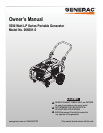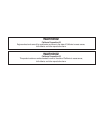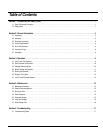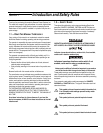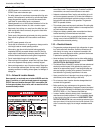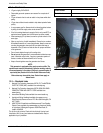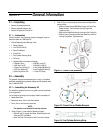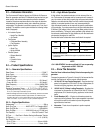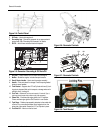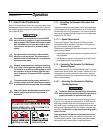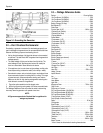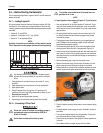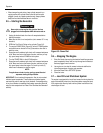
Introduction and Safety Rules
2 5,500 Watt LP Series Portable Generator
1.2.1 — General Hazards
• NEVER operate in an enclosed area, in a vehicle, or indoors
EVEN IF doors and windows are open.
• For safety reasons, the manufacturer recommends that the main-
tenance of this equipment is carried out by an Authorized Dealer.
Inspect the generator regularly, and contact the nearest Autho-
rized Dealer for parts needing repair or replacement.
• Operate generator only on level surfaces and where it will not be
exposed to excessive moisture, dirt, dust or corrosive vapors.
• Keep hands, feet, clothing, etc., away from drive belts, fans, and
other moving parts. Never remove any fan guard or shield while
the unit is operating.
• Certain parts of the generator get extremely hot during operation.
Keep clear of the generator until it has cooled to avoid severe
burns.
• Do NOT operate generator in the rain.
• Do not alter the construction of the generator or change controls
which might create an unsafe operating condition.
• Never start or stop the unit with electrical loads connected to
receptacles AND with connected devices turned ON. Start the
engine and let it stabilize before connecting electrical loads. Dis-
connect all electrical loads before shutting down the generator.
• Do not insert objects through unit’s cooling slots.
• When working on this equipment, remain alert at all times. Never
work on the equipment when physically or mentally fatigued.
• Never use the generator or any of its parts as a step. Stepping on
the unit can stress and break parts, and may result in dangerous
operating conditions from leaking exhaust gases, fuel leakage, oil
leakage, etc.
1.2.2 — Exhaust & Location Hazards
Never operate in an enclosed area or indoors! NEVER use in the
home, in a vehicle, or in partly enclosed areas such as garages,
EVEN IF doors and windows are open! ONLY use outdoors and
far from open windows, doors, vents, and in an area that will not
accumulate deadly exhaust.
• The engine exhaust fumes contain carbon monoxide, which you
cannot see or smell. This poisonous gas, if breathed in sufficient
concentrations, can cause unconsciousness or even death.
• Adequate, unobstructed flow of cooling and ventilating air is criti-
cal to correct generator operation. Do not alter the installation or
permit even partial blockage of ventilation provisions, as this can
seriously affect safe operation of the generator. The generator
MUST be operated outdoors.
• This exhaust system must be properly maintained. Do nothing that
might render the exhaust system unsafe or in noncompliance with
any local codes and/or standards.
• Always use a battery operated carbon monoxide alarm indoors,
installed according to the manufacturers instructions.
• If you start to feel sick, dizzy, or weak after the generator has been
running, move to fresh air IMMEDIATELY. See a doctor, as you
could have carbon monoxide poisoning.
1.2.3 — Electrical Hazards
• The generator produces dangerously high voltage when in opera-
tion. Avoid contact with bare wires, terminals, connections, etc.,
while the unit is running, even on equipment connected to the
generator. Ensure all appropriate covers, guards and barriers are
in place before operating the generator.
• Never handle any kind of electrical cord or device while standing
in water, while barefoot or while hands or feet are wet. DANGER-
OUS ELECTRICAL SHOCK MAY RESULT.
• The National Electric Code (NEC) requires the frame and external
electrically conductive parts of the generator be properly con-
nected to an approved earth ground. Local electrical codes may
also require proper grounding of the generator. Consult with a
local electrician for grounding requirements in the area.
• Use a ground fault circuit interrupter in any damp or highly con-
ductive area (such as metal decking or steel work).
• Do not use worn, bare, frayed or otherwise damaged electrical
cord sets with the generator.
• Before performing any maintenance on the generator, discon-
nect the engine starting battery (if equipped) to prevent accidental
start up. Disconnect the cable from the battery post indicated by a
NEGATIVE, NEG or (–) first. Reconnect that cable last.
• In case of accident caused by electric shock, immediately shut
down the source of electrical power. If this is not possible, attempt
to free the victim from the live conductor. AVOID DIRECT CON-
TACT WITH THE VICTIM. Use a non-conducting implement, such
as a rope or board, to free the victim from the live conductor. If the
victim is unconscious, apply first aid and get immediate medical
help.



